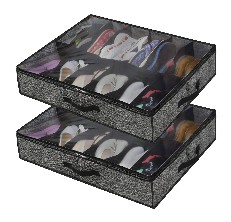This content was originally published on OldHouseOnline.com and has been republished here as part of a merger between our two businesses. All copy is presented here as it originally appeared there.
We all love our homes and want to protect them at all costs. Unfortunately, sometimes certain incidents are out of our control and can cause severe damages to our property and even our lives. Fire-related accidents are included in these common mishaps and this is exactly why we have curated a list of the top Class A Fires Extinguishers of 2023 that will help increase your fire safety.
According to the National Fire Protection Association, a home fire was reported every 93 seconds in 2023.
Well, if these misfortune accidents are so common, you’d want to be fully prepared in case one occurs. A class A fire is caused by common inflammable items such as wood, plastic, paper, and cloth. While it might sound insignificant, it’s the most common type of fire-related accident. But, don’t panic! Once you’ve been equipped with the greatest class A fire extinguishers, you’d be able to deal with such incidents. A good extinguisher is both easy to use, effective during accidents, and also provides great value for money.
To save you from the stress and effort of research, we’ve picked our favorite class-a fire extinguishers, and reviewed them in the following section!
What is the Best Class A Fire Extinguisher?
First Alert Fire Extinguisher
– Top Pick
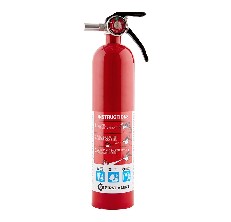
We’ll start with our favourite pick. This all in one fire extinguisher by first alert is good for putting out class A, B, and C fire. The dry chemicals make it safe for usage on ordinary flammable items as well as electrical equipment and other liquids like gasoline. It’s not all about what’s inside it though! The safety seal on top alongside a water-resistant label makes it the most user-friendly fire extinguisher on this list.
Fire extinguishers are considered expensive. So don’t worry about buying a new one after every discharge! You can get it recharged by a certified authority
Pros
- A safe and strong metal design makes it highly durable and convenient to use
- Safe to use on various kinds of fire
- First alert is the most reliable brand when it comes to safety equipment
Cons
- The product is approved for marine-usage and hence quickly runs out of stock
Kidde Fire Extinguisher
– Runner Up
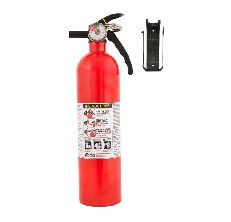
Our second pick is another easy to use piece of equipment. This extinguisher comes with a strong metal valve, a handle for stability, and a lever to avoid any accidental discharges. It contains 1.25 gallons of extinguishing agents and can work on a fire spread at 10 square feet. You can rely on it for a class A, B, or C fire.
We found its gauge to be the most exciting feature as you can see when the equipment is charged. We know how hectic fire extinguishers can be, but all you need to do here is pull the safety-pin and you’re good to go!
Pros
- A strong metal design makes the extinguisher rust-free and lightweight
- It is certified to use on all three classes of fire
- The labels are very clear and simple to follow
Cons
- Kidde provides a 6-year warranty compared to 10-years provided by most others
Amerex Fire Extinguisher
– Honorable Mention
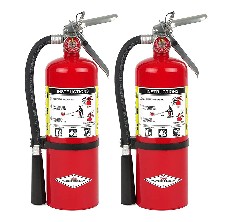
Our first two picks are more suitable for smaller apartments. If your home covers a larger area the Amerex B500 is your go to option! This package provides two large steel cylinders that are suitable for a Class A, B, or C fire. Each cylinder contains 2.5 gallons of extinguishing agents and hence weighs around 10 pounds.
The valve is made using pure-metal and hence can withstand higher and lower temperatures. It’s also a rechargeable piece of equipment and hence can be safely used for a long time. The chemical agents inside impose a coating over the material that has catched a class A fire and hence work effectively and swiftly.
Pros
- An ideal package for those who need larger extinguishers
- Both the pieces come with wall brackets to hang on
- The instructions on the label are clear and quite easy to follow
Cons
- Slightly expensive compared to other options
ABC Dry Chemical Fire Extinguisher
– Also Consider
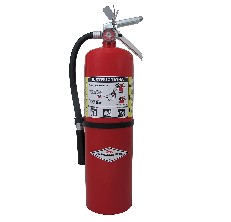
Just like our last pick, this extinguisher by Labelmaster is designed for larger areas. The cylinder can hold upto 5 gallons of ammonium phosphate but is extremely lightweight (2 pounds). The dry chemical melts at higher temperatures and coats the equipment that have caught a class A fire. The metal valve comes with a tough aluminium support, a handle, and a lever.
Each piece comes with a simple manual to guide you in case you have to use it. The loop pull pin also helps avoid any accidental discharges.
Pros
- A multi-purposed cylinder approved for usage on class A, B, and C fire
- It fully discharges the chemicals inside within 20 seconds of pulling the lever
- Comes with a wall bracket to hang on
Cons
- It is slightly heavier on the pocket
Buckeye Fire Extinguisher
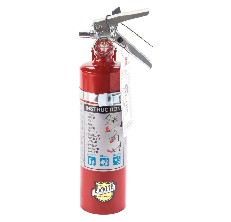
Our final pick has been specifically designed to withstand physical wear and tear in areas with harsh temperatures. The strong steel body, alongside a grippy aluminium valve makes it an ideal and user-friendly piece of equipment. You can also get it recharged for multiple uses.
Keep an eye on that gauge! The color coded theme indicates the readiness of the extinguisher. The vehicle brackets that come with it also make it feasible to carry around in cabs and trucks. The instruction manual and label guides will further relieve you from the hassle of learning how to operate it!
Pros
- It’s a very strong and yet lightweight piece of equipment
- The agents within are certified to work on class A, B, and C fire
- Comes with a long-term warranty
Cons
- It has a lesser capacity compared to the other options on this list
Buying Guide for the Best Class A Fire Extinguishers
Fire hazards can occur naturally and due to mishaps. We all love our backyards, but a scorching summer’s heat can cause a grassfire that can be wildly damaging if not put out instantly. Similarly, our kitchen stoves are always a huge threat if not handled smartly. Finally, the advent of electrical appliances, switches, and wires has opened an all-new threat of fire within our houses.
Before looking for the best fire extinguisher it’s important to understand the common kinds of fire accidents that an average person usually encounters. These categories dictate what class of fire extinguishers should be used in each case.
Which Fire Classes Should You Be Aware Of
According to UCLA health, there are four majorly identified classes of fire.
Class A
This is the most common kind and refers to the fire caught on by common solid inflammable items. These can include paper, wood, and even cloth.
Class B
Any flammable liquid that is suited to be extinguished by smothering falls under this category. Fires caused by items such as gasoline, grease, and alcohol all fall under this category.
Class C
The fire caused by electrical items including wires, equipment, sockets have become fairly common in recent times. These incidents need agents that are poor conductors so that the flames could be put out while avoiding any shock-related hazards.
Class D
This type is caused by combustible metallic substances. For instance, sodium and potassium are high-risk elements and if not used carefully can start a hazardous fire. This class is very uncommon in residential areas and usually occurs in labs.
We’re basically talking about extinguishers that work on a class-A fire. It’s usually smaller than the other kinds and can be tackled using pressurized water. Never use a class-A fire extinguisher on other classes of fire as it can create further complications!
To avoid such complications we made sure our list comprises multi-purposed equipment that can be used on all classes common in residential areas.
Features To Look Out for in Class a Fire Extinguishers
Now that we know what different classes of fire and extinguishers signify, let’s move onto some of the main features you should be looking out for before making a purchase.
Light and strong exterior
The body of the cylinder should be tough enough to withstand corrosion and decay over time. This might sound insignificant right now, but there’s a high chance you don’t use the product for a long time. Decay and rust on the metallic body and valve will not only spoil its look but can also lead to discharge and decay of the agents within.
Many class-A fire extinguishers are heavy to lift and hence difficult to use in times of need. So go for a lightweight option that you can easily grab onto in case an accident occurs.
Instructions and guidelines
Well, we all need to take part in an occasional fire drill, but accidents are unexpected and you wouldn’t want to be figuring out what to do at that time. So make sure the cylinder you buy comes with clear-cut labels and a concise instruction manual that is easy to comprehend. The best options come with labels that stay intact over time hence acting as guidelines during the incident itself.
Covered range
Now, this is a design feature that distinguishes the best options from the good ones. An average extinguishing cylinder can cover a range of up to 15 feet. Some might cover a fewer areas as well. However, most of our picks can cover 18 feet and some might even go up to 20 feet.
The ideal range depends upon the size of your residence or workplace. If you live in a larger area then buy cylinders with a greater range. You can even go with multiple extinguishers on each floor if necessary!
Charging option
Fire extinguishers are long-term investments to your home safety. You do not want to go for a cylinder that is used once and then becomes good for nothing. The advanced models come with an option of recharge. You can visit an authorized source after each discharge. After a quick evaluation of the cylinder, they’ll refill it and you’ll be good to use it again.
Whatever you do, never rely on an already used cylinder!
What More?
This is not an everyday product. It’s not something you buy for pleasure or out of sheer interest. These agents are meant for your safety and we care about that too! So let’s just review a general set of guidelines that must be followed no matter which class-A fire extinguisher you buy.
Always place the wall holders near your exit. This way you can instantly walk away when the flames get out of hand. Frequently conduct/attend fire drills at your places of work for a better display of how things actually play out. Go over the guidelines listed by NFPA in this regard and also carefully read the instruction manual that comes with the cylinder.
As a final piece of advice, please never forget that your life is more important than any piece of property! Accept the situation when it gets out of hand and walk out.
Class A Fire Extinguisher FAQ
Q: Which extinguisher should be used on a Class A fire?
A: Extinguishers that are filled with pressurized water are best for putting out a class A fire. The categories are clearly listed and you can search for class A fire extinguishers in particular, or go through our list to make the desired pick! ABC extinguishers are also suitable for this class of fire.
Q: Is an ABC fire extinguisher OK for the kitchen?
A: Yes! It is the best option to go for. Kitchens usually contain a wide array of equipment that can be solid or liquid, and even electrical. So just to be extra cautious, you’d need a multi-purpose fire extinguisher that is certified for use on all classes of fire.
Q: How often should you replace your fire extinguisher?
A: The industry standard is 12 years in this regard. A good quality cylinder will be suitable for usage during this period. However, try to be extra cautious and occasionally get it checked by an expert.
Q: Should fire extinguishers be replaced after use?
A: This is not necessary. Opt for rechargeable fire extinguishers and get the agents refilled after every usage!






